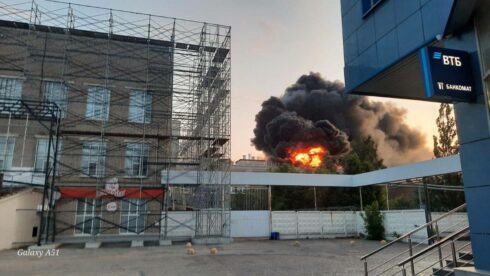On the night of June 9, Russian air defenses intercepted 49 Ukrainian unmanned aerial vehicles (UAVs) across multiple rear regions, including Kursk, Nizhny Novgorod, Voronezh, Oryol, Bryansk, Belgorod, and the Chuvash Republic. However, despite these efforts, at least two drones penetrated defenses and struck a critical military-industrial facility in Cheboksary, the capital of Chuvashia, located over 700 kilometers from the frontline.
The target of the attack was the All-Russian Research Institute of Radio Engineering (VNIIR-Progress), a key manufacturer of “Kometa” electronic warfare receivers, which protect Russian military drones from Ukrainian jamming systems. Eyewitnesses reported at least two UAVs—identified as “Lyutyi” (Furious) strike drones—flying over the city before multiple explosions rocked the area. According to preliminary reports, one drone was shot down by air defenses, while two others struck the institute, causing a fire that forced a temporary halt in production. Local authorities confirmed that fourth UAV reportedly crashed in a field outside the city without causing damage.
Russian authorities, meanwhile, have downplayed the incident. Chuvashia’s governor, Oleg Nikolaev, assured the public that emergency services quickly contained the fire and that no casualties were reported. However, the temporary shutdown of VNIIR-Progress disrupts the production of crucial electronic warfare components, potentially affecting Russian drone operations on the battlefield.
The successful attack on Cheboksary underscores Ukraine’s growing ability to conduct long-range precision strikes against high-value military-industrial targets. The “Lyutyi” drones, with an estimated range of 1,000 kilometers, are capable of evading detection due to their low radar signature and terrain-following flight patterns. Their ability to carry explosive or shaped-charge warheads makes them particularly dangerous for infrastructure and production facilities.
This incident also highlights some vulnerabilities in Russia’s air defense network. While Russian forces successfully intercepted drones over several regions, the attack on Cheboksary demonstrates that Ukrainian operators are finding gaps in the system—either by exploiting low-altitude flight paths or identifying weakly defended sectors thanks to the data provided by NATO intelligence.







in the photo above you can see a metal structure to protect the building againts drones
than they’ll use multiple drones. lol
mass production sites needed, well spread out, each producing or able to produce the d’same product or parts thereof.
russia will fall if continue with this weakness… the weak always perish
ukraine have lost complety the huges industrial military plants of antonov, motor sichs, yuzhmash, malyshev due russian attacks using iskander, cruise missile, oreshnik, kh 22, drones
underground facilities if possible.
vladolf wants the demilitarization of russia to continue, that’s why he hasn’t stopped occupation, stealing, lying, looting, raping.
daily penetration of russia happening…heheheh
nothing substitutes look down patrols but a big audio network monitoring system (with volunteer cellphones from the population included) might clue in mobile air defense teams move to better locations to take down such bayraktar style drones with manpads, flak, and small arms fire.
in ww2 the english used blimps with cables to reduce v1 buzzbomb/cruisemissile. a blimp network could provide high quality audio and video, and perhaps even launch interceptor drones.
why don’t you put nets or wire fencing around these facilities russia, like iran does many of their facilities? wtf am i missing?
it is war. consider the converse – most western cities have virtually no defence whatever against drones, or indeed missiles of any sort, not excluding v2 and v3. consider too the law of diminishing returns.
also, the opportunity cost to ukrainian society of each drone – of the impacts of the state of war that they represent – is clearly far far higher than for russia.